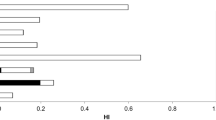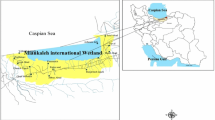Abstract
Concentrations of mercury and arsenic in fish from the Persian Gulf were determined by graphite furnace atomic absorption spectrometry. Concentrations of the metals in muscle samples were 0.049–0.402 μg g−1 for mercury and 0.168–0.479 μg g−1 for arsenic, with means of 0.133 and 0.312 μg g−1, respectively. The maximum daily consumption rate (grams per day) and meal consumption limit (meals per month) was calculated to estimate health risks associated with fish consumption. According to the results, the maximum allowable consumption rate varies between 8–56 and 15–96 g/day base on mercury and arsenic content, respectively. The results of this study indicate that the concentration of mercury and arsenic is well below the maximum permissible levels for mercury (0.5 μg g−1) and arsenic (6 μg g−1) according to international standards.
Similar content being viewed by others
References
Agah, H., Leermakers, M., Gao, Y., Fatemi, S. M., Katal, M. M., Baeyens, W., et al. (2010). Mercury accumulation in fish species from the Persian Gulf and in human hair from fishermen. Environmental Monitoring Assessment, 169, 203–216.
Alina, M., Azrina, A., Mohd Yunus, A. S., Mohd Zakiuddin, S., Mohd Izuan Effendi, H., & Muhammad Rizal, R. (2012). Heavy metals (mercury, arsenic, cadmium, and plumbum) in selected marine fish and shellfish along the Straits of Malacca. International Food Research Journal, 19, 135–140.
ANZFA. (1998). Food Standards code. Standard A12, Issue 37. Australia New Zealand Food Authority, Australian government publishing service.
Canli, M., & Furness, R. W. (1993). Toxicity of heavy metals dissolved in seawater and influences of sex and size on metal accumulation and tissue distribution in the Norway lobster Nephrops norvegicus. Marine Environmental Research, 36, 217–236.
Commission of the European Communities (2006). Commission regulation (EC) no. 1881/2006 of 19 December 2006 setting maximum levels for certain contaminants in foodstuffs. Official Journal of the European Union, The commission of the European communities, Brussels, L364–5/L364-24.
Emami Khansari, F., Ghazi-Khansari, M., & Abdollahi, M. (2005). Heavy metals content of canned tuna fish. Food Chemistry, 93, 293–296.
EPA. (1999). National Guidance: Guidance for assessing chemical contaminant data for use in fish advisories, volume 2: risk assessment and fish consumption limits, third edition, U.S. EPA, Washington, D.C.
FAO/WHO. (2004). List of maximum levels recommended for contaminants by the Joint FAO/WHO Codex Alimentarius Commission.
Foata, J., Quilichini, Y., Torres, J., Pereira, E., Spella, M., Mattei, J., et al. (2009). Comparison of arsenic and antimony contents in tissues and organs of brown trout caught from the river Presa polluted by ancient mining practices and from the river Bravona in Corsica (France): a survey study. Archive of Environmental Contamination and Toxicology, 57, 581–589.
Houseuova, P., Kuban, V., Kracmar, S., & Sitko, J. (2007). Total mercury and mercury species in birds and fish in an aquatic ecosystem in the Czech Republic. Environmental Pollution, 145, 185–192.
Jureša, D., & Blanuša, M. (2003). Mercury, arsenic, lead, and cadmium in fish and shellfish from the Adriatic Sea. Food Additives and Contaminants, 20, 241–246.
Kannan, K., Smith, R. G., Lee, R. F., Windom, H. L., Heitmuller, P. T., Macauley, J. M., et al. (1998). Distribution of total mercury and methyl mercury in water, sediment, and fish from South Florida estuaries. Archives of Environmental Contamination and Toxicology, 34, 109–118.
Khansari, F. E., Ghazi-Khansari, M., & Abdollahi, M. (2005). Heavy metals content of canned tuna fish. Food Chemistry, 93, 293–296.
Liao, C. M., & Ling, M. P. (2003). Assessment of human health risks for arsenic bioaccumulation in tilapia (Oreochromis mossambicus) and large-scale mullet (Lizamacrolepis) from blackfoot disease area in Taiwan. Archives of Environmental Contamination and Toxicology, 45, 264–272.
MAFF. (1995). Monitoring and surveillance of non-radioactive contaminants in the aquatic environment and activities regulating the disposal of wastes at sea, 1993. Aquatic environment Monitoring Report No. 44., Lowestoft: Directorate of Fisheries Research.
Oze, R., Oze, C., Anunuso, C., Ogukwe, H. N., & Okorie, K. (2006). Heavy metal pollution of fish of Qua-Iboe River Estuary: possible implications for neurotoxicity. International Journal of Toxicology, 3, 56–59.
Raissy, M., Rahimi, E., Ansari, M., & Ebadi, A. (2010). Determination of mercury and arsenic levels in fish caught in the Beheshtabad River, Chaharmahal and Bakhtiari Province, Iran. Toxicological and Environmental Chemistry, 92, 1627–1631.
Raissy, M., Ansari, M., & Rahimi, E. (2011). Mercury, arsenic, cadmium, and lead in lobster (Panulirus homarus) from the Persian Gulf. Toxicology and Industrial Health, 27, 655–659.
Raissy, M., Rahimi, E., Nadeali, V., Ansari, M., & Shakerian, A. (2012). Mercury and Arsenic in Green Tiger Shrimp from the Persian Gulf. Toxicology and Industrial Health, online published.
Rezayi, M., Esmaeli, A. S., & Valinasab, T. (2011). Mercury and selenium content in Otolithes ruber and Psettodes erumei from Khuzestan Shore, Iran. Bulletin of Environmental Contamination and Toxicology, 86, 511–514.
Saei-Dehkordi, S. S., Fallah, A. A., & Nematollahi, A. (2010). Arsenic and mercury in commercially valuable fish species from the Persian Gulf: Influence of season and habitat. Food and Chemical Toxicology, 48, 2945–2950.
Shah, A. Q., Kazi, T. G., Arain, M. B., Baig, J. A., Afridi, H. I., Kandhro, G. A., et al. (2009). Hazardous impact of arsenic on tissues of same fish species collected from two ecosystems. Journal of Hazardous Materials, 167, 511–515.
Tuzen, M. (2009). Toxic and essential trace elemental contents in fish species from the Black Sea, Turkey. Food and Chemical Toxicology, 47, 1785–1790.
Voegborlo, R. B., El-Methnani, A. M., & Abedin, M. Z. (1999). Mercury, cadmium, and lead content of canned tuna fish. Food Chemistry, 67, 341–345.
World Health Organization (WHO). (1993). Revision of WHO Guidelines for Water Quality. Geneva: WHO.
Zhiyou, F., Fengchang, W., Dulasiri, A., Changli, M., Bijun, L., Jing, Z., et al. (2010). Antimony, arsenic, and mercury in the aquatic environment and fish in a large antimony mining area in Hunan, China. Science of the Total Environment, 408, 3403–3410.
Author information
Authors and Affiliations
Corresponding author
Rights and permissions
About this article
Cite this article
Raissy, M., Ansari, M. Health risk assessment of mercury and arsenic associated with consumption of fish from the Persian Gulf. Environ Monit Assess 186, 1235–1240 (2014). https://doi.org/10.1007/s10661-013-3452-4
Received:
Accepted:
Published:
Issue Date:
DOI: https://doi.org/10.1007/s10661-013-3452-4




